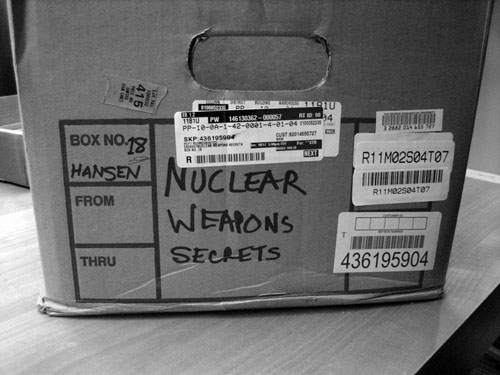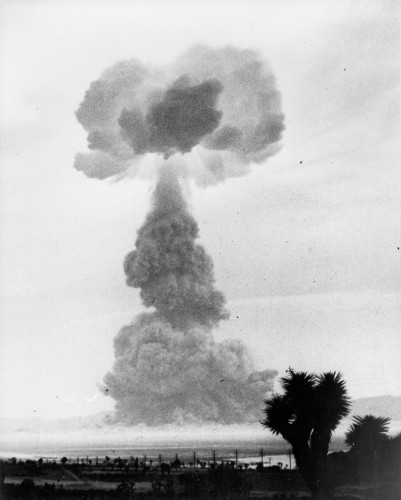I spent some of the last week in the National Security Archive, a private archive hosted by George Washington University, looking at the papers of Chuck Hansen (1947-2003). Hansen was one of the great nuclear researchers, meticulously compiling thousands upon thousands of nuclear documents by means of archival visits, Freedom of Information Act requests, and crawling of the public literature. His books, U.S. Nuclear Weapons (1988) and Swords of Armageddon (1995), were the final products of this trawling. They weren’t scintillating reads, but they’re chock full of interesting technical details derived from his voluminous archives.

How many boxes do you have lying around with “NUCLEAR WEAPONS SECRETS” written on the side of them? Answer truthfully.
I found a lot of useful files for a number of projects I’m working on (including the oft-mentioned book), but I also found a few highly amusing things as well. Chief among these is a song composed by someone at the Operation Upshot-Knothole nuclear test series, held at the Nevada Test Site in 1953. What’s really remarkable about it is that it appears to use the classified names of the actual nuclear devices, earning it a nice “SECRET” rating. How many “SECRET” songs do you know?1
It follows a little poem about setting up the tests which is not quite as good, except for the final stanzas:
As someone says, without aplomb
“We just can’t seem to find the bomb.”
So D (for day)
Looks pretty gray
For something’s surely gone agley
No bomb? Oh well
And what the hell?
We’ll try again some other day.
Below is a transcription; the original can be viewed here. The names of the devices have been blacked out in the original, but through referencing Hansen’s published work (he ferreted them out from here and there), his speculations in the margins (some of which must be right, some of which must be wrong), along with some of the internal indications (e.g. puns, character spaces), I think I’ve worked out what they are meant to be:
There were ten little gadgets, sitting in a line
[XR-3] was X-quisite and then there were nine.There were nine little gadgets, the tower held the weight,
[ZOMBIE] had a kick to it, and then there were eight.There were eight little gadgets (oh, NPG2 is heaven?)
They couldn’t hide the [HYDRIDE-1,] and then there were seven.There were seven little gadgets, brought out for kicks,
[DIXY]3 was deuti-full4, and then there were six.There were six little gadgets, pretty much alive,
[BUZZARD]5 said “let’s carrion”, and then there were five.There were five little gadgets, they couldn’t find no more,
[HYDRIDE-2]6 kicked up its heels, and then there were four.There were four little gadgets, observers came to see,
One was [SIMULTANEITY,] and then there were three.There were three little gadgets, [HAMLET] got his due,
The time was not so out of joint, and then there were two.There were two little Gadgets, [ENCORE]7 said this is fun,
The military got Effects, and then there was one.There was one little gadget, that lonesome little Gun,8
They shot the hell right out of it
And
then
there
was
NONE.
Someone else (not Hansen) has hand-written “Climax!” at the bottom of the page, here — indicating, perhaps, that the original poem was written before the final, late addition to the Upshot-Knothole schedule was added. The eleventh shot, approved at the very last minute as a special addition to the series was shot CLIMAX.9
The whole thing looks a little more ominous, though, when you know that Upshot-Knothole had some fairly negative public health effects. The ninth shot, HARRY (the “HAMLET” device, above) was extremely dirty — a lot of fallout resulted and contaminated nearby St. George, Utah. As Richard Hewlett and Jack Holl put it:
Postponed for three days because of unfavorable weather, Harry was fired under what seernecl to be perfect conditions. But a wind shift and a slight increase in wind velocity spread fallout in a pattern about fifty miles square over populated areas east of the proving ground. For the second time in a month roadblocks were set up on major highways to monitor motor vehicles. At 9:10 a.m., about four hours after the shot had been fired, readings as high us 0.32 roentgens per hour were being recorded at the roadblocks. At that time Edward S. Weiss, the Public Health Service officer stationed in St. George, called the sheriff’s oflice and radio station to warn people in the area to take cover. Local schools kept children indoors during the morning recess, and the washing of contaminated cars in St. George was suspended. By 9:40 a.m. most of the population in St. George was under cover, and the community came to a standstill. … From measurements at St. George the test group later estimated that the maximum amount of external exposure that could have been received at St. George was 6.0 roentgens and 5.0 roentgens at Cedar City.10
That’s probably not enough to kill you by itself, to be sure, but it’s still some thousands of times higher than the average background radiation, higher than the maximum “safe” dose that had previously been established for the entire test series, and just one of the many tests that rained fallout on the people in those towns. It may, even, have been responsible for killing John Wayne and much of the cast of The Conqueror, too. (I’m usually dubious about attributing individual deaths to such exposures — the probabilistic nature of such cancers makes it very hard to attribute them on an individual level, as opposed to an epidemiological level — though the rates for the cast, and the types of cancers involved, are particularly disturbing.)
The people running the test shot were hardly ignorant of such possibilities. Consider the first lines of the “poem” that preceded the “song”:
We’ll all be safe
As Rad can be
For milliroentgens frighten meAnd if a meter
Starts its clickin’
We will run to beat the dickens
So it’s all fun and games… unless the winds shift.
- Citation: Poem and song about Operation Upshot-Knothole (ca. May 1953), copy in the Chuck Hansen papers, National Security Archive, George Washington University, Box 18, “1953,” folder 1. [↩]
- NPG = Nevada Proving Ground = Nevada Test Site. [↩]
- This might not be right. The spacing is four letters; nothing obviously fits. It can’t be “RUTH” because that’s one of the HYDRIDEs. “DIXIE” is the official name of the test, though one can imagine the scribe got the spelling wrong. The device name for DIXIE was apparently “DEUTERIUM,” which goes with the sentence. [↩]
- Amusingly, this is the only part of the song that made it into Hansen’s published work. Footnote 534 of Volume II of Swords of Armageddon reads: “An untitled, undated classified poem issued sometime soon after the end of UPSHOT-KNOTHOLE states that the fourth shot ‘was deuti-full.’ The device may have used a solid or crystalline lithium deuteride boosting charge.” [↩]
- Hansen thought this might be HYDRIDE-2, because it is the next in order. But “let’s carrion” must be a reference to BUZZARD, no? Plus it fits perfectly with the spacing. [↩]
- Might also be “DEUTERIUM,” the device name for the DIXIE shot. [↩]
- Well, this is and isn’t right. The space here is only four letters. But the ninth device was dubbed “EFFECTS” and was test “ENCORE” so it’s got to be something about that. Maybe it was spelled eccentrically, like NCOR? Or something like XR-3. [↩]
- This is, of course, the famous GRABLE atomic cannon shot. Apparently the censor did not know that GUN was its device name, and it was not redacted. [↩]
- The eleventh was needed because an earlier shot failed to reach its full yield. The device in question, COBRA, was the primary for at least one of the devices in the CASTLE series and its exact yield needed to be known ahead of time. Eisenhower was very irritated by the last-minute addition and approved it only because it meant they could cancel another test series, DOMINO, that had been planned for later in the year. [↩]
- Richard G. Hewlett and Jack M. Holl, Atoms for Peace and War, 1953-1961: Eisenhower and the Atomic Energy Commission (University of California Press, 1989), 154. [↩]




More about cancers among the cast of “The Conqueror” can be found in this 1980 People magazine article (which may well have broken the story, or at least made it much more widely known).
I used to live in St. George and it is true: there is fine dust everywhere. The climate is hot and arid and I imagine in the 50’s there were fewer plants and lawns and golf courses to keep the dust down. But Snow Canyon (where some of the filming for the Conqueror took place) is all red dirt from the giant red cliffs. Very beautiful but I didn’t know about its radioactive history.
Thanks for this interesting write up.
The shot GRABLE picture in your calendar is fantastic, by the way.
[…] Link. Towards the end of this piece a surprising connection from a sober source. […]
[…] sort of thing happens all the time, of course. In the National Security Archive’s Chuck Hansen papers there are bundles of little stapled “books” he would create of multiply, […]
As it happens, Harry dropped more fallout on Huerfano County, CO than Washington. Fallout at that range would be microscopic, smaller than flour or concrete dust, essentially invisible. Harry happened 2 years before the filming of The Conqueror, by which time the fallout would have decayed to several thousands of times less intense than the fallout from the Teapot series, which ended just about the time the shoot was starting. Oh, and, contrary to what the People Magazine article said, the number for percentage of people who will be diagnosed with cancer in their lifetimes stands at 43%, so 91 out of 220 is actually a little low. The writer of the utahgothic article is very gullible.
I did like the poem and your guesses. You have it about as right as we’ll probably ever know.